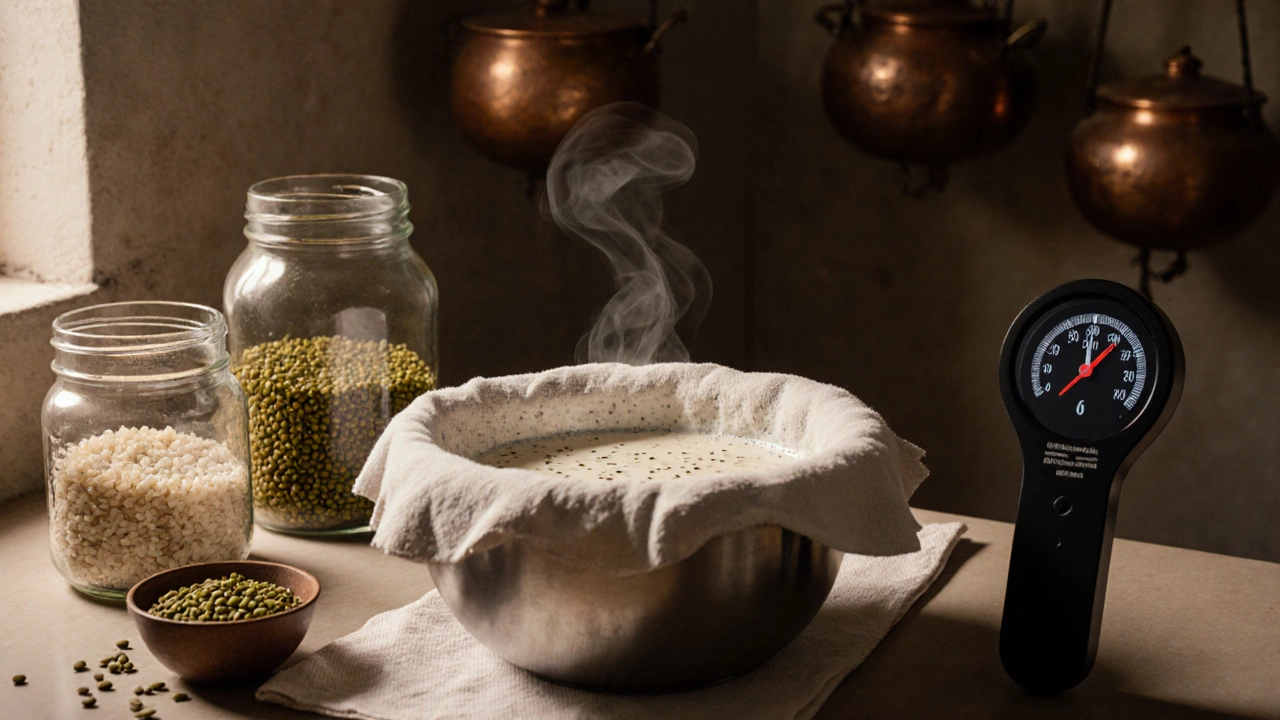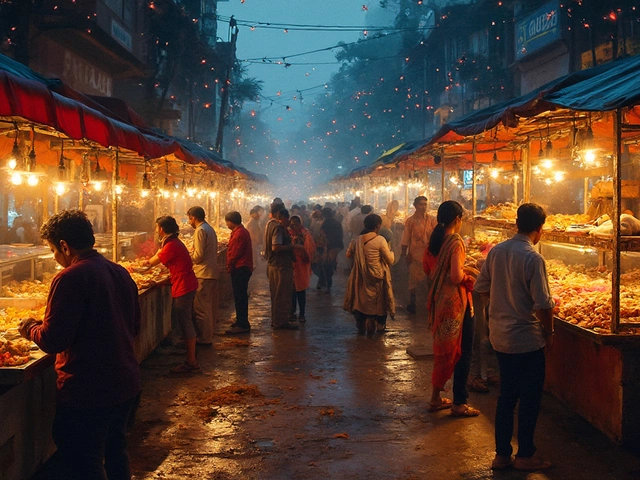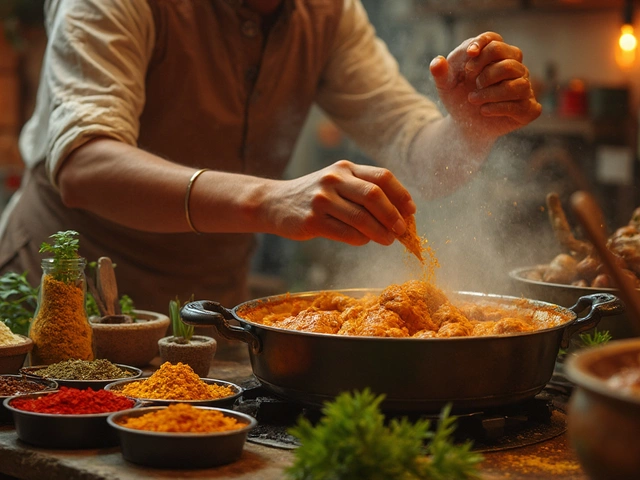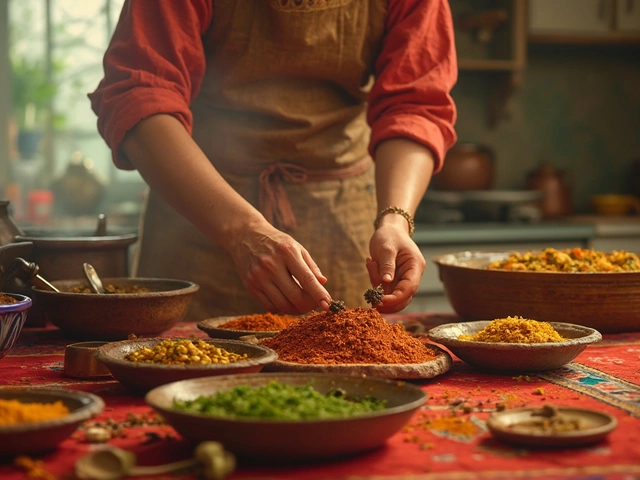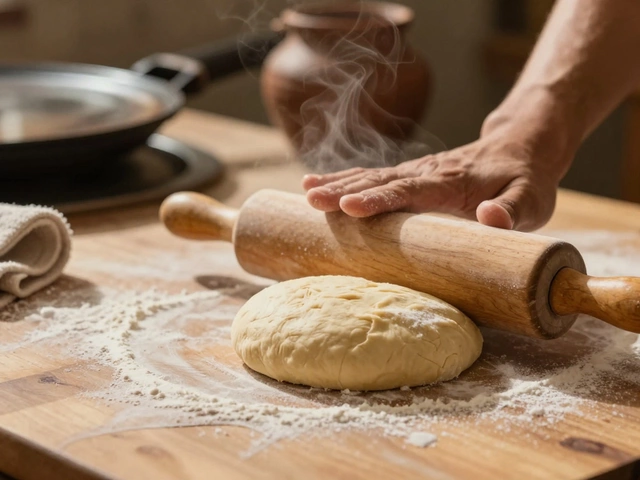Dosa Browning Troubleshooter
Select the most common symptom you're experiencing with your dosa. The tool will provide specific causes and fixes based on the article.
Pro Tips
Add a pinch of baking soda (¼ tsp) to the batter before cooking to accelerate browning.
Season your tawa properly for better heat transfer and browning.
Use the 2:1 rice-to-urad dal ratio for optimal protein-to-sugar balance.
Quick Takeaways
- Proper fermentation (8‑12hours at 30‑35°C) is key to brown spots.
- Use a 2:1 rice‑to‑urad dal ratio; too much rice keeps the dosa pale.
- A hot, well‑seasoned tawa creates the Maillard reaction that browns the surface.
- Thin batter, a steady medium‑high heat, and a quick spread give the classic golden‑brown look.
- Small adjustments-adding a pinch of baking soda or a few fenugreek seeds-can rescue stubborn pale dosas.
When a Dosa is a thin, crisp Indian crepe made from fermented rice‑and‑urad‑dal batter, a golden‑brown surface signals the right balance of fermentation, heat and batter consistency. If you keep wondering why your dosa not brown issue persists, you’re probably missing one of those critical steps. Below we break down every factor that influences the color and give you a step‑by‑step rescue plan.
What Gives a Dosa Its Brown Color?
The brown hue isn’t magic; it’s the result of the Maillard reaction-a chemical process that occurs when proteins and sugars on the batter’s surface heat up quickly. For a dosa, three ingredients fuel this reaction:
- Urad dal supplies the protein.
- Rice provides the reducing sugars.
- Heat from a hot tawa (flat Indian griddle) creates the high temperature needed (around 200°C).
If any of these three elements is out of balance, the dosa stays pale.
1. Fermentation: The Unsung Hero
Fermentation does two things: it generates natural acids that improve flavor, and it breaks down starches into simple sugars that brown more easily. Here’s the checklist:
- Mix rice and urad dal in a 2:1 weight ratio (e.g., 2cups rice to 1cup dal).
- Grind to a smooth batter and add water to achieve a pourable consistency (about 1mm thickness).
- Cover and let ferment for 8‑12hours at 30‑35°C. In cooler climates (like Cape Town in October), place the bowl in a warm oven with the light on.
Signs of good fermentation: a slightly sour smell, tiny bubbles, and a volume increase of about 30‑40%.
If the batter looks flat, smells sweet, or hasn’t risen, the Maillard reaction won’t have enough sugars, resulting in a white or light‑yellow dosa.
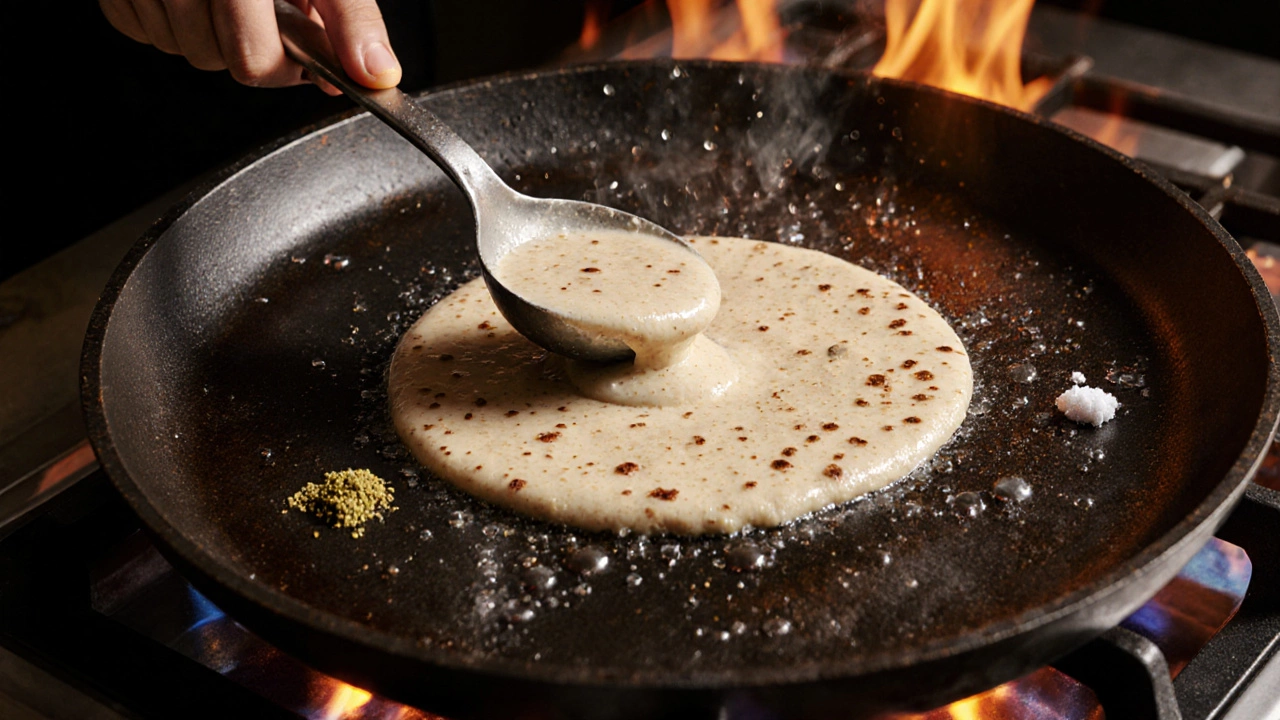
2. Ingredient Ratios and Add‑Ins
Even a perfectly fermented batter can stay pale if the rice content overwhelms the protein. Adjust these ratios:
- Stick to the 2:1 rice‑to‑urad dal rule. Using more rice (>2.5 parts) dilutes proteins and reduces browning.
- Include a small amount of fenugreek seeds (½tsp per cup of dal). They boost enzyme activity, helping sugars form faster.
- If you’re in a hurry, add a pinch (¼tsp) of baking soda right before cooking. The alkaline environment accelerates the Maillard reaction.
3. Heat Management: From Lukewarm to Blazing
Most home cooks make the mistake of cooking a dosa on medium‑low heat, hoping for a gentle crisp. The reality is that a dosa needs a hot, evenly heated surface.
- Pre‑heat the tawa for at least 3‑4 minutes. Sprinkle a few drops of water; they should sizzle and evaporate instantly.
- Set the burner to medium‑high. If you have an infrared thermometer, aim for 200‑210°C (390‑410°F).
- Spread the batter in a thin, circular motion (about 2mm thickness). Thick batter traps moisture, preventing the surface from reaching browning temperatures.
When the tawa is too cool, the batter cooks slowly, steam escapes, and the dosa stays white.
4. Tawa Quality and Seasoning
A seasoned cast‑iron or seasoned carbon steel tawa develops a natural non‑stick layer that also contributes to browning. If you’re using a non‑stick pan, you might notice lighter colors because the surface doesn’t get as hot.
Season a new cast‑iron tawa:
- Scrub clean, dry, and coat lightly with oil.
- Heat on low for 10minutes, then increase to high until the oil smokes.
- Let it cool, wipe excess oil, and repeat 2‑3 times.
After a few uses, the tawa will develop that perfect dark patina that helps the dosa brown quickly.
5. Batter Consistency and Resting Time
Even with perfect fermentation, a batter that’s too thick will spread poorly, creating pockets of moisture that keep the surface pale.
- After fermentation, stir the batter gently. If it feels like thick pancake batter, thin it with water-add a tablespoon at a time.
- Let the thinned batter rest for 15‑20minutes before cooking. This allows the water to integrate fully, giving a uniform spread.
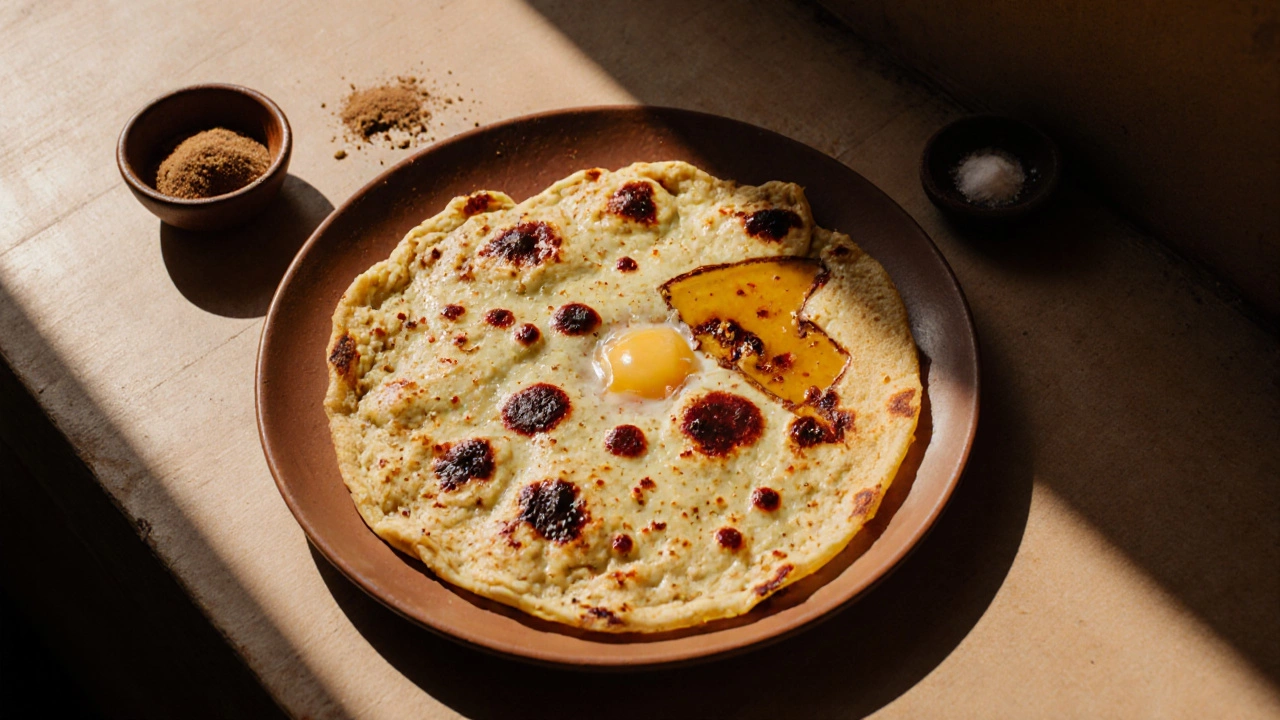
6. Troubleshooting Checklist
| Symptom | Likely Cause | Quick Fix |
|---|---|---|
| White or pale surface | Insufficient fermentation | Ferment 2‑4 extra hours in a warm spot |
| Uneven brown spots | Hot spots on tawa | Pre‑heat tawa longer; rotate pan during cooking |
| Sticky batter that won’t spread thin | Too much rice or too little water | Add water, 1‑2Tbsp per cup, and rest 15min |
| Grayish crust | Low cooking temperature | Increase burner to medium‑high; test with water drop |
| No crispiness | Over‑fermented batter (pH too high) | Use fresh batter; add a pinch of baking soda if needed |
7. Pro Tips from Indian Kitchens
These extras aren’t mandatory, but seasoned cooks swear by them:
- Add a few drops of oil to the batter before cooking; it helps the edges crisp and brown.
- Sprinkle a thin line of ghee around the edge of the dosa as it cooks. The fat conducts heat and creates a deeper hue.
- Use a mix of parboiled (idli) rice and regular raw rice. Parboiled rice has more reducing sugars, hastening the browning.
- For a subtle caramel flavor, add ½tsp of brown sugar to the batter after fermentation.
Putting It All Together: A One‑Day Dosa Blueprint
- Evening (Day1): Soak 2cups raw rice and 1cup urad dal (with ½tsp fenugreek) for 6hours.
- Drain, grind with water to a smooth, slightly thick batter.
- Cover and ferment overnight (8‑12hours) in a warm oven.
- Morning (Day2): Check for bubbles and a mild sour scent.
- Add a pinch of baking soda if fermentation looks weak.
- Thin the batter with water until it pours like a thin pancake batter; rest 15minutes.
- Heat a seasoned cast‑iron tawa until a water drop sizzles instantly (≈200°C).
- Lightly brush the surface with oil, pour a ladleful of batter, spread thin, and cook 1‑2minutes.
- When brown specks appear and the edges lift, flip (optional) or serve immediately.
Follow this routine and you’ll rarely see a dosa that refuses to turn brown.
Frequently Asked Questions
Why does my dosa turn brown on the edges but stay white in the center?
The center stays cooler because the batter layer is too thick or the tawa isn’t hot enough. Spread the batter thinner and make sure the pan is fully heated before pouring.
Can I use a non‑stick pan for dosa?
You can, but non‑stick surfaces don’t reach the high temperatures needed for deep browning. If you use one, increase the heat slightly and expect a lighter color.
Is it okay to add sugar to the batter?
A small amount (½tsp) can boost caramelization without making the dosa sweet. Too much sugar will hinder crispness.
My batter smells sour after a day, but the dosas are still white. What’s wrong?
The sour smell means fermentation is fine, but the rice‑to‑dal ratio may be off or the heat too low. Reduce rice slightly or increase the pan temperature.
Should I refrigerate the batter overnight?
Yes, if you live in a warm climate. In cooler areas, refrigerate for 12‑14hours to control over‑fermentation; bring to room temperature before cooking.
- Poplular Tags
- dosa not brown
- dosa color
- dosa batter
- dosa cooking tips
- Indian breakfast





